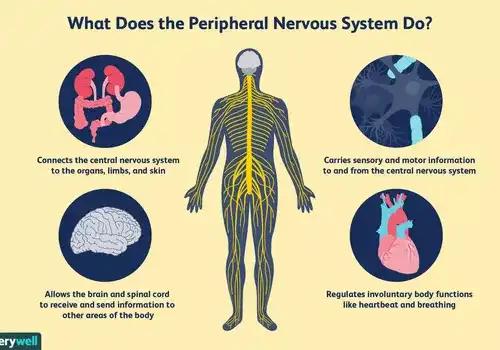What You Should Know About the Peripheral Nervous System
Curated from: verywellmind.com
Ideas, facts & insights covering these topics:
4 ideas
·744 reads
8
Explore the World's Best Ideas
Join today and uncover 100+ curated journeys from 50+ topics. Unlock access to our mobile app with extensive features.
The nervous system consists of two parts
- The central nervous system (CNS). It includes the brain and spinal cord.
- The peripheral nervous system (PNS). It includes all the nerves that branch out from the brain and spinal cord and extends to other parts of the body, including muscles and organs.
47
234 reads
The main role of the PNS
The PNS's primary role is to connect the CNS to the organs, limbs, and skin. The peripheral nervous system is divided into two parts:
- The somatic nervous system. It is responsible for carrying sensory and motor information to and from the CNS.
- The automatic nervous system. It is responsible for regulating involuntary body functions, such as heartbeat, digestion, breathing, and blood flow.
47
181 reads
The Somatic Nervous System
The somatic system is responsible for transmitting sensory information as well as voluntary movement. The system contains two major types of neurons:
- Motor neurons. They carry information from the brain and spinal cord to muscle fibers throughout the body. They allow us to take physical action.
- Sensory neurons. They allow us to take in sensory information and then carry the information from the nerves to the central nervous system.
51
145 reads
The Autonomic Nervous System
The autonomic system controls aspects of the body that are usually not under voluntary control. The autonomic system is divided into two branches:
- Parasympathetic system: It helps maintain normal body functions and conserve physical resources. Once a threat is over, this system will slow the heart rate, slow the breathing, reduce blood flow to muscles, and constrict the pupils.
- Sympathetic system: This system prepares the body to expend energy to respond to environmental threats - the flight or fight response.
48
184 reads
IDEAS CURATED BY
Jade R.'s ideas are part of this journey:
Learn more about health with this collection
Conflict resolution
Motivating and inspiring others
Delegation
Related collections
Similar ideas
5 ideas
Nervous System: Facts, Function & Diseases
livescience.com
4 ideas
Brain Anatomy and How the Brain Works
hopkinsmedicine.org
2 ideas
How We Get Stronger
nytimes.com
Read & Learn
20x Faster
without
deepstash
with
deepstash
with
deepstash
Personalized microlearning
—
100+ Learning Journeys
—
Access to 200,000+ ideas
—
Access to the mobile app
—
Unlimited idea saving
—
—
Unlimited history
—
—
Unlimited listening to ideas
—
—
Downloading & offline access
—
—
Supercharge your mind with one idea per day
Enter your email and spend 1 minute every day to learn something new.
I agree to receive email updates
